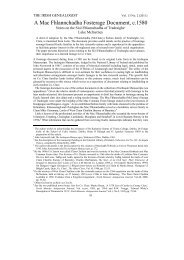Report Cover Vol I - Clare County Library
Report Cover Vol I - Clare County Library
Report Cover Vol I - Clare County Library
Create successful ePaper yourself
Turn your PDF publications into a flip-book with our unique Google optimized e-Paper software.
The <strong>County</strong> <strong>Clare</strong> Wetlands Survey Patrick Crushell & Peter Foss 2008<br />
____________________________________________________________________________________<br />
7.4 Distribution and extent of wetlands in <strong>County</strong> <strong>Clare</strong><br />
The <strong>County</strong> <strong>Clare</strong> Wetlands Survey has identified more than 2069 discrete wetland mapped areas within<br />
the county, with an area of 23,440 ha, which represents 7.4 % of the area within the entire county.<br />
In terms of the main habitat types in <strong>County</strong> <strong>Clare</strong> the results suggest that on a county basis, the 23,440<br />
ha of wetland recorded, cover the following percentage of the county: lakes 2.57% , bogs and wet heaths<br />
2.52%, fens & flushes, marsh, reedbeds and wet grassland cover 1%, while the remaining 1% has been<br />
assigned to the CWS unknown wetland type.<br />
The average area of each habitat unit was 11.3 hectares, which comprised the following size categories:<br />
• 37% of all habitat units were less than 1 hectare<br />
• 46% were between 1 and 10 hectares in extent<br />
• 17% were between 10 and 60 hectares<br />
Less than 0.1% were more than 60 hectares in extent<br />
Therefore the vast majority (81%) of habitat units were less than 10 hectares in extent. While generally<br />
speaking the larger habitat areas would be of higher conservation value, a large number of smaller sites<br />
are especially important as they can offer connectivity at the landscape scale between the larger habitat<br />
patches. Furthermore, some important habitat types typically occur as small discrete sites such as poor<br />
fen, dune slack and spring habitats.<br />
Detailed information is stored on 300 wetland sites in the CWS Site database. These wetland sites occur<br />
within and outside of recognised conservation worthy areas. Figure 7.1 below shows the location of CWS<br />
sites identified, represented as points, in <strong>County</strong> <strong>Clare</strong>. The boundaries (where they have been drawn,<br />
see Appendix 4) of these sites are included in Figure 7.2. Extensive data that has been extracted from<br />
existing data sources for each of these sites is stored in the CWS site database and the GIS database.<br />
It is clear from Figure 7.2 that a considerable number of wetland sites have been surveyed in <strong>County</strong><br />
<strong>Clare</strong>, although the distribution of sites tends to be biased towards the region of the Burren in the<br />
northern part of the county. In contrast there are areas of the county that appear to be poorly<br />
represented most notably the South western part of the county (area between Inagh, Cooraclare and<br />
Kilmurry) and the Eastern part of the county (area between Tulla, Broadford and Scarriff). It is possible<br />
that these areas contain less wetlands of conservation importance due to topographical and hydrological<br />
conditions.<br />
However, from an analysis of the detailed habitat distribution map of the county (not shown), there<br />
appears to be an abundance of unsurveyed wetlands in these parts of the county. The true value of these<br />
areas for wetland biodiversity will remain unknown until systematic field surveys are carried out.<br />
The <strong>County</strong> <strong>Clare</strong> Wetlands Survey has identified more than 2069 discrete wetland habitat areas (total<br />
extent 23,440 ha), mainly by collating existing mapped data but also through the identification of<br />
unknown wetland sites by aerial photograph analysis. Due to resolution difficulties created by the scale of<br />
the county no large scale complete high resolution wetland habitat map of the county is presented in this<br />
report, although an example of the final CWS GIS layout with the various CWS shape-files presented is<br />
shown in Figure 7.3. This map is only for illustration purposes therefore the habitat polygons are all<br />
indicated by the same colour (red).<br />
Two 10km squares representing two different parts of the county (R17 and R58, see Figure 7.4 below for<br />
details of their location) were selected to illustrate the extent of the habitat mapping within the CWS GIS.<br />
Figure 7.5a shows the overall habitat distribution for the 10km square R17 and Figure 7.5b shows the<br />
south-eastern part of this square in greater detail. Similarly Figure 7.6a and 7.6b show the same habitat<br />
maps for the 10km square R58.<br />
To obtain a complete overview of the wetland distribution in county <strong>Clare</strong> based on the results of this<br />
study, the reader is asked to consult the GIS map file contained on the CD accompanying this report. It is<br />
envisaged that the GIS will be primarily used as an exploratory and research tool in future biodiversity<br />
inventories of the county, as mentioned earlier this should only be used as a crude indicative habitat<br />
map.<br />
By analysing the GIS, it is clear that most of the bog sites occur in the upland areas in the east and west<br />
of the county, with a significant number of raised bogs (at the south western extremity of their range)<br />
occurring in the low-lying areas of South <strong>Clare</strong>. Unsurprisingly bogs are largely absent from the limestone<br />
49
















